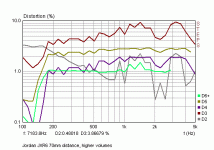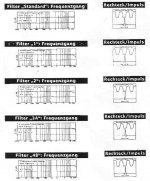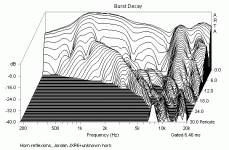I agree. What about higher harmonic distortions? Can they be equally or more audible than 3nd? I'm not sensitive to 2nd but 3nd is probably what I hear from JXR6 (more than it's small ringing) - a kind of harmonic distortion CSD is useful tool here. Appended photo illustrates the problem - ca. 2V peak to peak.
Attachments
jzagaja said:I agree. What about higher harmonic distortions? Can they be equally or more audible than 3nd? I'm not sensitive to 2nd but 3nd is probably what I hear from JXR6 (more than it's small ringing) - a kind of harmonic distortion CSD is useful tool here. Appended photo illustrates the problem - ca. 2V peak to peak.
You appear to be unaware of my work in this area - its not simple and reading the AES papers is the best way to educate yourself. To make a long story short, yes the higher harmonics are more audible, but it also depends on other factors.
I had in mind something simple - music sample and % threshold with digitally added distortions. You're referring to your Gm(f) metric so please write more how you can evaluate by this loudspeakers and amplifiers. Theory is fine as long you can use it practically.
I've got Sony CDPXA50ES AA filters spectra and time. With Mr Manger we used 3A aliasing filter which is non-symmetric and has no pre-ringing that is commonly applied these days in traditional mastering. New kind of mastering like DSD and switching amplifiers make it probably worse. So my question is have ever bothered with this kind of delicate distortion? So many people claim that analogue record has better spatial image. Same effect with 24/196 playback (see dcsltd.co.uk white papers). If Summa has good time resolution then it should be possible to examine this subject.
I've got Sony CDPXA50ES AA filters spectra and time. With Mr Manger we used 3A aliasing filter which is non-symmetric and has no pre-ringing that is commonly applied these days in traditional mastering. New kind of mastering like DSD and switching amplifiers make it probably worse. So my question is have ever bothered with this kind of delicate distortion? So many people claim that analogue record has better spatial image. Same effect with 24/196 playback (see dcsltd.co.uk white papers). If Summa has good time resolution then it should be possible to examine this subject.
Attachments
I shouldn't put DSD so low. The ringing is smallest achievable:
http://www.dddac.de/files/dsd_ringing.pdf
http://www.dddac.de/files/dsd_ringing.pdf
jzagaja said:I had in mind something simple - music sample and % threshold with digitally added distortions. You're referring to your Gm(f) metric so please write more how you can evaluate by this loudspeakers and amplifiers. Theory is fine as long you can use it practically.
What you suggest is what we did and we did apply it in "practice". I don't think it a good use of my time to reiterate things that have been published and are readily available from the AES. Just go to www.aes.org and order copies of my preprints. They are cheap.
gedlee said:
HOM - Higher Order Mode, its a term that I coined to define waves that propagate in a waveguide that do not go down the axis, but travel by bouncing off of the walls. They are not predicted by the Horn Equation, so most people didn't even know that they existed (I was the first person to hypothesize there existance). The Waveguide Theory predicts them, and low and behold, it turns out that they are quite significant to audibility. Minimizing them yields a far better sound quality. But with "horns" its not possible to minimize them because you don't know what to do - the equations aren't rigorous enough to predict them so they are simply ignored.
So a HOM is simply a sound wave that has reflected inside the horn or waveguide, right? When using a foam plug on my waveguides, I noticed that the reproduction sounded more articulate. For example, I was able to discern words in songs that I hadn't noticed before. My hypothesis is that the reflected waves muddy the articulation due to the time difference between the initial wave and it's reflections.
Imagine a good pair of headphones, and you get the general idea. Diffraction is a bad thing kids.
Patrick Bateman said:
So a HOM is simply a sound wave that has reflected inside the horn or waveguide, right? When using a foam plug on my waveguides, I noticed that the reproduction sounded more articulate. For example, I was able to discern words in songs that I hadn't noticed before. My hypothesis is that the reflected waves muddy the articulation due to the time difference between the initial wave and it's reflections.
Imagine a good pair of headphones, and you get the general idea. Diffraction is a bad thing kids.
Agreed - What I noticed was how readily I could hear flaws in music that I knew very well. For instance, with the Summas it's quite clear that Van Morrison is clipping the microphone signal on a few passages of Moondance, but I never noticed it before - more than thirty years of listening to that same song.
freddi said:makes sense -what losses vs frequency are seen with foam plug versus none?
Everyone looks at the foam, and wonders what effect it will have on the frequency. But all the magic is in the time domain. So let me explain...
The foam simply acts as a low pass filter. If your waveguide is only 4 inches across, the effect will be pretty subtle. If your wavguide is 15" in diameter, it will be pretty dramatic. HOWEVER, it's effect on the frequency response can be UNDONE with a corresponding filter.
It's effect on the time domain is where the magic happens. Picture a sound wave going down the length of the waveguide. A great deal of energy is reflected BACK to the throat. That energy is delayed in time, and psychoacoustic research demonstrates that these timing errors are very audible.
The foam simply absorbs those reflected waves. While the primary wave is absorbed ONCE, the reflected waves are absorbed a MINIMUM of THREE times. Draw it on paper and it makes more sense.
I could sweaaaar that I posted before & after measurements of the foams effect on my Unity waveguides. But for the life of me, I can't find the post. I also posted it on a thread about my old tractrix horns, which used it, but not so extensively.
http://www.audiogroupforum.com/csforum/showthread.php?t=62789
freddi said:can some old-school HF horn be viewed as adding a type of "reverb"? - how about basshorn?
Good questions! Yes, it is something like reverb. But the HOMs have a different response than the initial wave, due to the reflections. So it's kind of like reverb, except it sucks.
As for the effect on a basshorn, psychoacoustically we are very sensitive to EARLY reflections. Late reflections, like in a basshorn, are not as obnoxious.
freddi said:thanks PB- got lost in those fascinating threads
--are there good (meaning affordable) online sources of foam and if so what specification/url?--are there some happy buidlers of hybrids with "basshorn" rather than reflex?
McMaster Carr -
http://www.mcmaster.com/nav/enter.asp?partnum=2195K52&pagenum=605
For my waveguides I make the foam plug the exact same way I make the waveguide itself. The way that I do *that* is documented on both audiogroupforum and htguide. I basically lay it up layer by layer.
This is not optimum for the plug. Based on conversations I've had with Dr Geddes, there's issues due to the transition from layer to layer. But I'm not going to do what he does (cuts it out of a solid "bun" of foam.
Way too much work there! Expensive too.
This is not optimum for the plug. Based on conversations I've had with Dr Geddes, there's issues due to the transition from layer to layer. But I'm not going to do what he does (cuts it out of a solid "bun" of foam.
Way too much work there! Expensive too.
Lets keep in mind that below about 1 kHz (500 Hz certainly) the audibility of timing delayed aberration events falls off very fast. I would not think that foam would have any effect on LF devices. I try and control the diffraction only above about 1 kHz. I don't worry about it too much below 500 Hz.
The use of layers depends on how you hold the layers together. A lot of glue would be a real problem, no glue could also be a problem - getting this right could be tricky, which is why I use a solid block. It takes some doing to cut it, but I now get very clean pieces.
The use of layers depends on how you hold the layers together. A lot of glue would be a real problem, no glue could also be a problem - getting this right could be tricky, which is why I use a solid block. It takes some doing to cut it, but I now get very clean pieces.
gedlee said:It takes some doing to cut it, but I now get very clean pieces.
Electric carving knife? That's the classic for carving foam. Or hot wire.
What kind of foam are you using ?
The foamplug seems interesting to me since I use some BMS4540ND driver in some 16cm diameter custom made waveguides (used from 4kHz upwards with 60db/oct crossover) They sound pretty good but still excibit some "sqeekiness" wich I have handled too some extend with my DEQX correction unit but I think an acoustical correction would work better in this case. Besides this little "sqeekiness" they sound more "real life" and dynamic then my ESS air motion transformers. The AMT's have got more inner detail though and sound more sophisticated. Though choise wich one is realy better, realy depends on the combination with the mid driver and amplifier choice, specially the BMS can sound awfull on some amps and brilliant on others. they both got there strenghts but at the moment I prefer the impact and lifelike dynamics of the BMS waveguides, getting rid of that last piece of harshness and a bit more air and detail would make it the perfect tweeter (and I have tried dozens of the most expensive high end stuff out there)
The foamplug seems interesting to me since I use some BMS4540ND driver in some 16cm diameter custom made waveguides (used from 4kHz upwards with 60db/oct crossover) They sound pretty good but still excibit some "sqeekiness" wich I have handled too some extend with my DEQX correction unit but I think an acoustical correction would work better in this case. Besides this little "sqeekiness" they sound more "real life" and dynamic then my ESS air motion transformers. The AMT's have got more inner detail though and sound more sophisticated. Though choise wich one is realy better, realy depends on the combination with the mid driver and amplifier choice, specially the BMS can sound awfull on some amps and brilliant on others. they both got there strenghts but at the moment I prefer the impact and lifelike dynamics of the BMS waveguides, getting rid of that last piece of harshness and a bit more air and detail would make it the perfect tweeter (and I have tried dozens of the most expensive high end stuff out there)
Sjef said:What kind of foam are you using ?
The foamplug seems interesting to me since I use some BMS4540ND driver in some 16cm diameter custom made waveguides (used from 4kHz upwards with 60db/oct crossover) They sound pretty good but still excibit some "sqeekiness" wich I have handled too some extend with my DEQX correction unit but I think an acoustical correction would work better in this case. Besides this little "sqeekiness" they sound more "real life" and dynamic then my ESS air motion transformers. The AMT's have got more inner detail though and sound more sophisticated. Though choise wich one is realy better, realy depends on the combination with the mid driver and amplifier choice, specially the BMS can sound awfull on some amps and brilliant on others. they both got there strenghts but at the moment I prefer the impact and lifelike dynamics of the BMS waveguides, getting rid of that last piece of harshness and a bit more air and detail would make it the perfect tweeter (and I have tried dozens of the most expensive high end stuff out there)
Source for the foam is listed in my post above.
BMS 4540nd is the same compression driver that I'm using in my foam loaded waveguides. You could probably steal my crossover and use it as a starting point. Heaven knows that I didn't come up with it on my own - it's a heavily tweaked version of the crossover from the Lambda Acoustics Unity. That xover was done by Tom Danley I believe.
http://www.audiogroupforum.com/csforum/showthread.php?t=62789
Hi,
I'm wondering if there is any waveguide/horn available (for diy), that would come close to the Gedlee OS waveguide.
I found the 18Sound XT1086 'Constant Coverage HF Horn' mentioned here and there, and the measurements look great, but how does it perform in reality...
Also the Monacor Wg-300 it supposed to work quite well with several dome tweeters, but it is rather small so it only works above 2kHz.
best,
LC
I'm wondering if there is any waveguide/horn available (for diy), that would come close to the Gedlee OS waveguide.
I found the 18Sound XT1086 'Constant Coverage HF Horn' mentioned here and there, and the measurements look great, but how does it perform in reality...
Also the Monacor Wg-300 it supposed to work quite well with several dome tweeters, but it is rather small so it only works above 2kHz.
best,
LC
- Home
- Loudspeakers
- Multi-Way
- Geddes on Waveguides


